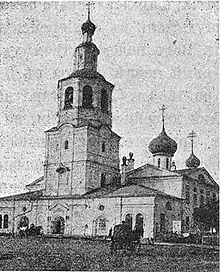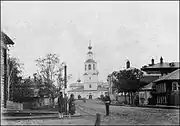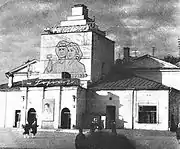Vsegradsky cathedral (Vologda)
The Vsegradsky cathedral (original Спасо-Всегра́дский собо́р) was one of the main historical monuments in Vologda. It was rebuilt from a wooden church in 1688–1698, which was established after a severe plague outbreak in 1654. The cathedral had the revered Icon «Saviour, the Most Merciful (everyday)».[1][2]
| The Vsegradsky cathedral | |
Всеградский Обыденный собор во имя Спаса Всемилостивого | |
 The cathedral in the early 20th century | |

| |
| Location | Vologda |
|---|---|
| Country | Russia |
| Denomination | Christianity |
| History | |
| Status | Demolished |
| Founded | 1654 |
| Architecture | |
| Years built | 1688—1698 |
| Closed | 1924 |
| Demolished | 1972 |
History

Construction
The very first wooden church was built on the 18 of October, 1654, following the Russian tradition of ‘one-day’ churches. Such buildings were constructed in one single day, using powers of all the citizens, and thus thought to be pure from evil and disease. The church in Vologda was aimed to free it from the plague outbreak, which lasted for 7 weeks and took many lives. When the church was finished, the plague miraculously stopped. Amazed by this, the citizens asked local icon painter to create an icon in gratitude for God's mercy. The icon was also created in one day, it became the most important relic in the city.[3][1]
The name Vsegradsky in translation from Russian means ‘by all town’, because the money and the effort for construction were given by all the citizens.[2][1]
In 1688 the small church could no longer take all the pilgrims, so it was rebuilt in stone right on top of the wooden carcase. Meanwhile, the church remained active and the liturgical services were continued. The construction was finished in 1691, but due to an unknown reason in 1692 the cathedral crashed. Then it was rebuilt in 1698, in 1718 the interiors were decorated with frescoes.[1]
In the 19th century the cathedral was changed several times, gradually it completely lost its original view. In 1840-1842 the refectory and the 'warm' church were rebuilt. In 1851-1853 the building underwent a full-scale reconstruction when all the frescoes were repainted, the altar enlarged, the windows widened and the floors replaced.
Gallery
 The cathedral in 1887
The cathedral in 1887 The cathedral before 1917
The cathedral before 1917 The cathedral, rebuilt into a cinema hall, mid 20th century
The cathedral, rebuilt into a cinema hall, mid 20th century
References
- Vinogradova 2013, p. 188-189.
- Egorov, B. (2020-02-07). "Why were some Russian churches built in a day?". Russia Beyond The Headlines. Retrieved 2020-01-29.
- Malevinsky 1866.
- Vinogradova 2013, p. 189-191.
Sources
- Vinogradova, E. A.; Fedyshin, I. N.; Fedyshin, N. N. (2013). "Икона из Вологодского Спасо-Всеградского собора "Спас Всемилостивый (Обыденный)" и её списки в собрании Вологодского музея-заповедника" [The Icon «Saviour, the Most Merciful (everyday)» and Its Copies in the Collection of Vologda Museum] (in Russian). Vologda: Pskov State University. Cite journal requires
|journal=(help) - Malevinsky, A. (1866). Сказание о милости Божией и о создании храма во имя Господа Бога и Спаса нашего Иисуса Христа, в городе Вологде, ради избавления его от смертоносной язвы [The Legend of God’s Mercy in Rescue Vologda from Plague and the Creation of Vsegradsky cathedral]. Vologda State Museum Archives.